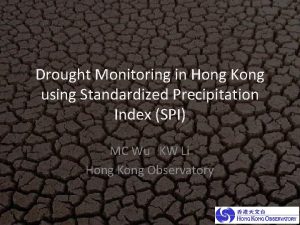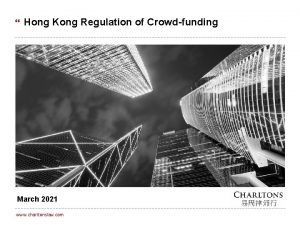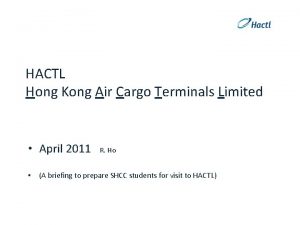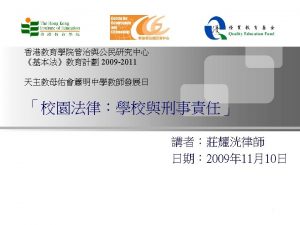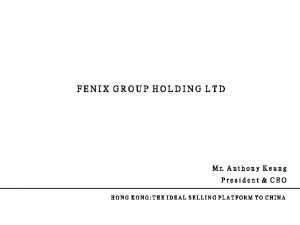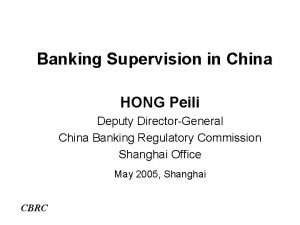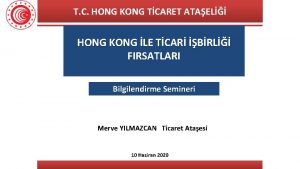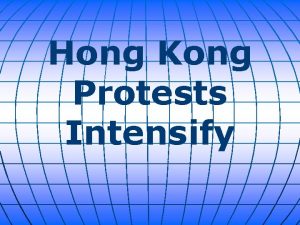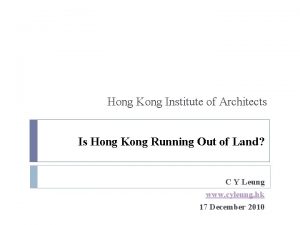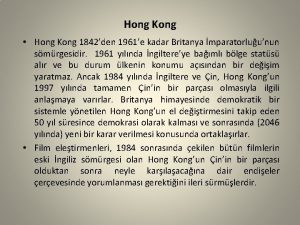Drought Monitoring in Hong Kong using Standardized Precipitation



















- Slides: 19

Drought Monitoring in Hong Kong using Standardized Precipitation Index (SPI) MC Wu KW Li Hong Kong Observatory

Historical Droughts in Hong Kong • Serious droughts in 1963 & 1967 • Water restriction supply in 4 hours every 4 days

Rainfall in Hong Kong Average 2399 mm Highest 3343 mm (1997) Lowest 901 mm (1963)

Water Resources • Building Reservoirs – Plover Cove (1968), High Island (1978) • Importing water from Dongjiang River in Guangdong province Year Volume of importing water from Dongjiang River (billion cubic meters per year) 1960 0. 227 1964 0. 68 1976 1. 09 1982 2. 2 2012 8. 2

Allocation of Dongjiang Water Currently, around 80% of Hong Kong’s total fresh water demand are supplied by Dongjiang water

What is Drought? • Different perceptions for different people living in different climate zones – Sahara desert: less than 10 mm / year – Cherrapunji (northeast of India): more than 10000 mm / year • Three main types based on its impacts on different aspects: Ø Meteorological drought Ø Agriculture drought Ø Hydrological drought

Types of Drought Temporal Scale Short Fine Spatial Scale Long Meteorological drought - measured the amount of dryness and the duration of dry period Meteorological Agricultural drought - based on the impacts to agriculture Hydrological Broad Hydrological drought - refers to impacts on water supply

WMO Recommendation Standardized Precipitation Index (SPI) should be used as a universal meteorological drought index for more effective drought monitoring and climate risk management (2009) A user guide on SPI was issued in 2012

SPI - a probability index • Based on the cumulative probability of rainfall amount for any time scale • Fitted to a gamma distribution • Transformed into standard normal (mean = 0 and s. d. = 1) Cumulative Probability 1. 0 Normal~(0, 1) 0. 8 0. 6 0. 4 0. 20 0. 0 20 40 60 80 100 Precipitation (mm) 0. 2 -3 0. 0 -2 -1 0 1 SPI 2 3

SPI classification SPI values Category +2. 0 and above Extremely wet +1. 50 to +1. 99 Very wet +1. 0 to +1. 49 Moderately wet -0. 99 to +0. 99 Near normal -1. 0 to -1. 49 Moderately dry -1. 50 to -1. 99 Severely dry -2. 0 and less Extremely dry

Advantages of SPI • Simple – only rainfall is required as input parameter • Normalized – can be used to compare the drought severity for areas with different climates • Various time scale – can be used to assess different types of drought or for different planning purposes

SPI in different time scales • 3 -month SPI (SPI-3) – Provides information on short term and seasonal variation in ppt • 6 -month SPI (SPI-6) – Characterizes medium-term trends in ppt • 12 -month SPI (SPI-12) – Reflects the longterm ppt patterns • 24 -month SPI (SPI-24) – Characterizes persistent drought

SPI for monitoring persistent droughts in Hong Kong Extremely wet Extremely dry SPI-24

Characteristics of a drought event (i) (iii) (iv) Minimum SPI ≤ -1. 0 Duration: starts from SPI falling below zero and ends with SPI rising to zero Magnitude: the accumulated SPI between the drought duration Intensity = Magnitude / Duration SPI Duration 0 -1. 0 Magnitude (area) Time

Drought episodes in HK based on SPI-24 189509 -190306 (94 months) 196206 -196508 (39 months) 4 5 6 1 2 3 7 9 8 13 10 12 11 1963 16 14 15 17 18

The 18 episodes in Hong Kong between 1885 and 2012


Collaboration • SPI-24 for HK as well as the cities in Dongjiang River Basin such as Heyuen can provide useful reference information for the future management and planning of water resources in Hong Kong • Hong Kong Observatory is collaborating with the Water Supplies Department in utilizing climate information and products for drought monitoring and water resource management

 Hong kong drought
Hong kong drought Co precipitation and post precipitation
Co precipitation and post precipitation Co precipitation and post precipitation
Co precipitation and post precipitation Hong kong certificate of education examination
Hong kong certificate of education examination Hong kong institute of chartered secretaries
Hong kong institute of chartered secretaries Hong kong education city
Hong kong education city Hong kong triathlon association
Hong kong triathlon association Seng14 hong kong
Seng14 hong kong Crowdfunding hong kong
Crowdfunding hong kong Hactl
Hactl Business opportunities hong kong
Business opportunities hong kong Https://extranetapps.hongkongairport.com
Https://extranetapps.hongkongairport.com Boys and girls association
Boys and girls association Fenix group hong kong
Fenix group hong kong Fleet management ltd hong kong
Fleet management ltd hong kong Sense of touch sai kung
Sense of touch sai kung Stephen cheung hong kong
Stephen cheung hong kong Career plan
Career plan Hong kong peili
Hong kong peili Non jupas
Non jupas
